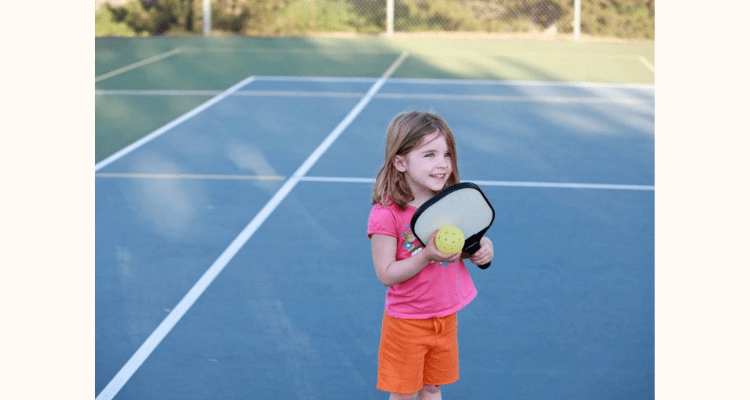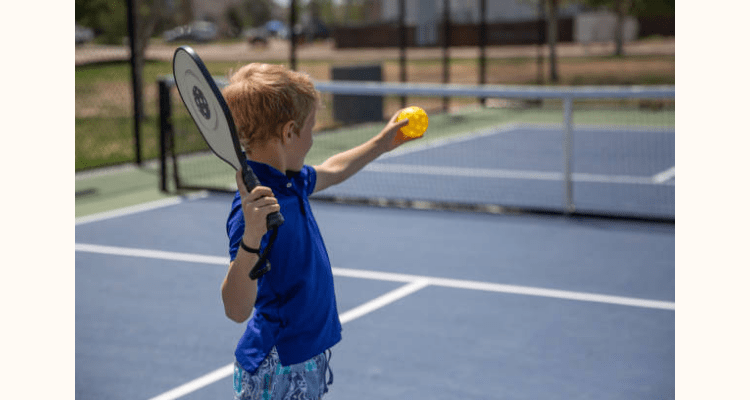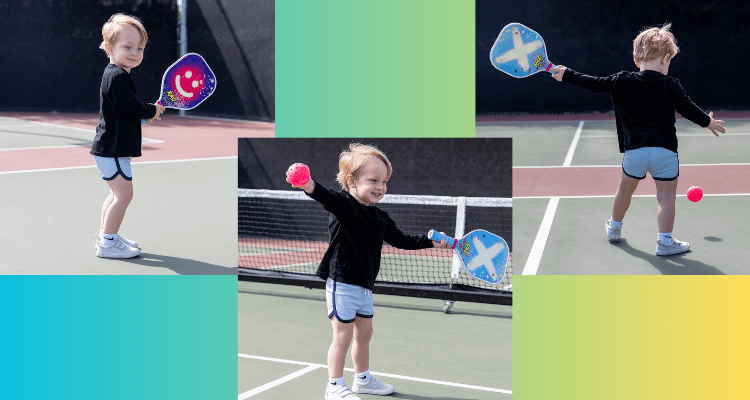Teach Pickleball to Your Kids: Are you looking for a fun and healthy sport that your kids can enjoy for a lifetime? Look no further than pickleball! Combining the best of tennis, badminton, and ping-pong, pickleball is a paddle sport that is easy to learn, fast-paced, and suitable for all ages and skill levels.
In this engaging article, we will show you how to teach your kids pickleball, from the basic rules and skills to the strategies that will make the game even more exciting. By the end of this read, you and your kids will be ready to grab your paddles and balls and hit the court in style. So, let’s dive right in!

How to Teach Pickleball to Your Kids?
Here are some tips to get you started if you wish to introduce your kids to the world of pickleball:
- Begin with the fundamentals. Before diving into the rules and strategies, make sure your kids are familiar with the equipment and how to grip and swing the paddle. You can practice with a wall or a partner, focusing on precision, reliability, and control.
- Make it enjoyable and interesting. Pickleball is all about having fun, so make sure it’s not too hard or dull for your kids. Use praise and motivation, play their favorite music, use bright balls and paddles, and create a fun environment. You can even make it a family activity and play with your kids or other parents and kids.
Recommend specific drills and games to help your kids develop and practice their pickleball skills. Here are some examples:
Teach Pickleball Drills for Your Kids:
- Serving drill: Have your kids practice serving the ball into the opposite service court while avoiding the no-volley zone. You can use cones or chalk to mark the target areas and give them points for hitting them. Challenge them to serve with different spins, speeds, or angles.
- Volleying drill: Have your kids volley the ball back and forth over the net without letting it bounce. You can use a softer or bigger ball to make it easier for them. Adjust the distance from the net or have them switch sides after a certain number of volleys.
- Dinking drill: Have your kids stand in the no-volley zone and practice hitting soft shots that land in the opponent’s zone. Use a harder or smaller ball to increase the difficulty. Make them move side to side or switch sides after a certain number of shots.
- Lobbing drill: Have your kids stand near the baseline and practice hitting high shots that go over the opponent’s head and land inbounds. Use a lower or higher net to adjust the difficulty. Have them move forward or backward or switch sides after a certain number of shots.
- Smashing drill: Have your kids stand near the no-volley zone and practice smashing the ball down at the opponent’s feet. Use a higher or lower net to adjust the difficulty. Make them move side to side or switch sides after a certain number of smashes.
- Positioning drill: Have your kids play doubles with you or another partner and practice positioning themselves correctly on the court depending on the situation. Teach them where to stand when serving, receiving, attacking, defending, hitting or returning a lob, and hitting or returning a dink.
Safety and Precautions
When playing pickleball, it’s important to prioritize safety. Here are some precautions and etiquette rules for your kids to follow:

- Wear proper footwear and comfortable clothing suitable for the weather and surface.
- Use appropriate equipment that is in good condition and fits their size and skill level.
- Respect opponents and officials by following the rules, being honest, polite, and courteous, avoiding arguments or complaints, and congratulating them after the game.
Follow the game’s rules, such as serving underhand from behind the baseline, allowing two bounces before volleying, staying out of the no-volley zone unless the ball bounces there first, scoring only when serving, and calling out the score before each serve.
Basic Rules and Objectives
Now, let’s dive into the basic rules and objectives of pickleball:
- Pickleball uses a paddle and a plastic ball with holes, similar to a Wiffle ball.
- Doubles, the more commonly played and recommended version for beginners, overshadow singles in the game.
- The court is 20 feet by 44 feet, divided by a net that is 36 inches high on the sidelines and 34 inches high in the center.
- The court has two areas, the no-volley zone and the kitchen, which are 7 feet from the net on each side. Players can only hit the ball in the air (volley) in the no-volley zone if the ball bounces first.
- Serves are made crosscourt diagonally from behind the baseline, underhand, to the opposite service court. The server must hit the ball below waist level and keep at least one foot behind the baseline until contact.
- The serve must clear the net and land on the service court, avoiding the no-volley zone. Let’s occur when serves hit the net but land on the service court. Except for the first service sequence of every new game, each server may only attempt one serve.
- The receiving team must let the serve bounce before returning it, and the serving team must let the return bounce before hitting it. This is known as the two-bouncing rule. After that, both teams can volley the ball or let it bounce once before hitting it, as long as they are not in the no-volley zone.
- Points are scored only by the serving team when the opposing team commits a fault, such as hitting the ball out of bounds, into the net, or in the no-volley zone on a volley.
- A team wins if they score 11 points and lead by at least two points. Different tournaments or leagues may have rules specifying 15 or 21 points for a game.
Why Is Pickleball Good for Kids?
Pickleball offers numerous benefits for kids. Here are just a few:

- It improves their physical fitness, coordination, agility, and balance. With all the running, swinging, and hitting involved, pickleball helps kids develop their muscles, bones, joints, and cardiovascular system.
- It fosters social skills, teamwork, sportsmanship, and confidence. Pickleball is a social sport that encourages interaction, communication, cooperation, and respect among players. Kids can make new friends, learn from others, and enjoy healthy competition.
- It can be adapted to different levels of difficulty and challenge. Pickleball can be played with different types of balls, paddles, and nets, allowing kids to modify rules or play different game variations to suit their preferences and skills.
FAQs
Yes, pickleball is easy for kids because it has simple rules, a small court, and a light paddle and ball. Kids can quickly learn the basics and have a blast playing with others.
You can start playing pickleball at any age, but most kids can begin around six years old. Pickleball can be adapted to different skill levels and abilities, allowing kids to enjoy the game at their own pace.
Absolutely! Pickleball is great for kids as it improves their physical fitness, coordination, agility, and balance. It also fosters social skills, teamwork, sportsmanship, and confidence. Pickleball is a fun and healthy activity for kids of all ages.
Wrap Up!
Pickleball is an exciting sport that can bring joy and health to your kids. By following these tips and tricks, you will be able to teach pickleball to your kids in a fun and effective way. Who knows, they might even become pickleball champions someday!
We hope you enjoyed this engaging article and learned something new about pickleball. If you did, please share it with your friends and family who might be interested in pickleball too.